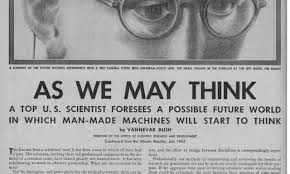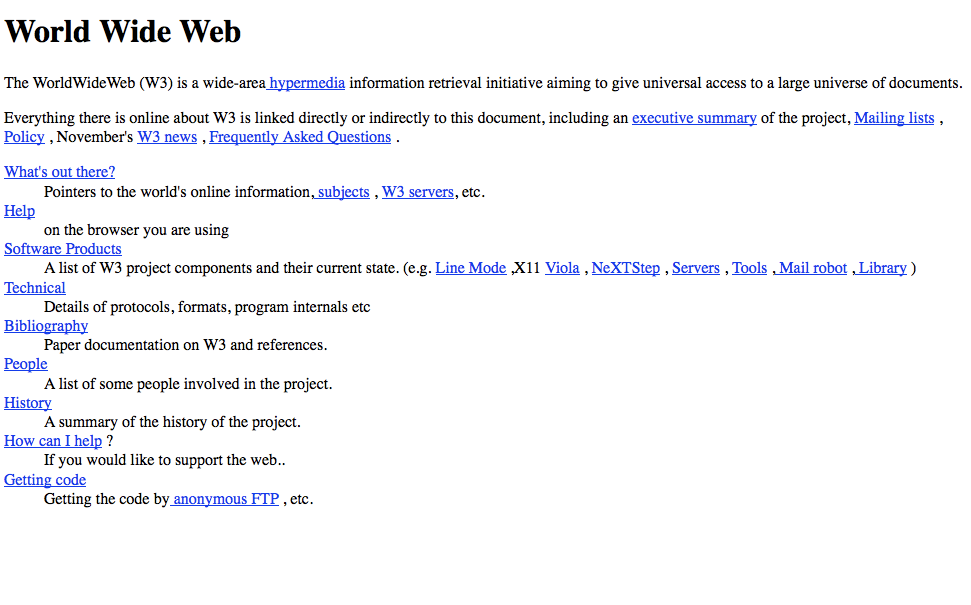On the Origins of The Web
(6 mins reading time)
The Web, in my opinion, is one of the most influential inventions the human kind had come up with since the invention of controlled fire 2 million years ago.
The web has always fascinated me since I was a child. I remember back in the days - 12 years or so - my first tries of programming was creating some html pages and linking them together with some css style sheets that made my pages look cool.
and since then... I've fallen in love.
The terms Internet and Web are often used interchangeably by non-tech people, although they are two different ideas. In simple words, the Internet is a device and the web is a software which run on this so called internet. In this post I'll talk about the philosophy and history of the web invention, and we'll maybe leave the internet for another blog post.
If we want to understand the idea of the web we need to dig deep in history, maybe way back to the origins of a fundamental concept called "HyperText", HyperText is defined by the man who coined it,Ted Nelson, in 1963 as:
A text which is capable of branching into other texts and responds.
The word "Hyper" comes from a greek prefix which means "Over" or "Beyond", and so by HyperText we mean a text which goes beyond a normal text we see in newspapers or books. A text which can point to another texts... Imagine a book which its paragraphs can have strings attached to them that points to other books' paragraphs indicating a similar idea the paragraph is talking about or trying to make a reference to it.
This branching text idea dates way back before Ted Nelson's HyperText, the first man who tried to make an analog device which implements this idea goes to Vannevar Bush in 1945 who theorized an analog device called Memex (Bush described it as "As we may think"). With Memex, individuals can store big stacks of texts or books and create associations between them, so they can link and follow.

Bush came up with his idea from a famous spanish short story called The Garden of Forking Paths. the story talks about a world where all possible outcomes of an event occur simultaneously, each one itself leading to further proliferations of possibilities.

So we've found 'till now that a spanish writer had written a short story which inspired Bush to theorize a device which we can use to make branching texts, then Nelson with some colleague, coined the term "HyperText" and introduced it to the world of computers by 1963, so far so good.
After that, the world started working on new ideas and implementations for the HyperText, Nelson started a project called Xanadu, the very first HyperText project in which individuals can create, store and edit documents and link them with HyperJumps or HyperLinks (a deliverable of the project was released in 2014 as OpenXanadu), and we also had alot of HyperText projects (editors, interfaces..) and systems like FROSS, HyperCard, ENEQUIRE (by Tim Berners-Lee)...etc, but most of them were experimental or by the end were overshadowed by the most successful implementation of the HyperText, the World Wide Web.
OK, let's back up a little, while the HyperText was being coined in the 1960s, a new invention was being cooked too, a research was commissioned by US government to build a robust and fault-tolerant communication system using computer networks for academic and military purposes, by the time international collaborations started developing this global network, private and commercial networks were also starting, ISPs started to emerge too by the early 1990s. In 1990 the first high speed link (1.5Mb) between Cornell University in New York City and Conseil Européen pour la Recherche Nucléaire (CERN) was established, which I think is the key-event which made the birth of the World Wide Web possible.
By the time CERN had "Internet Connection", Tim Berners-Lee was working at CERN and he has already been working on some HyperText projects earlier in his life like ENQUIRE, so he had envisioned the idea of global hyperlinked information system, he emphasizes his idea as marrying Hypertext to Internet in his book "Weaving the Web", he says in an interview at the Academy of Achievement:
"I just had to take the hypertext idea and connect it to the Transmission Control Protocol and Domain Name System ideas and—ta-da!—the World Wide Web... Creating the web was really an act of desperation, because the situation without it was very difficult when I was working at CERN later. Most of the technology involved in the web, like the hypertext, like the Internet, multifont text objects, had all been designed already. I just had to put them together. It was a step of generalising, going to a higher level of abstraction, thinking about all the documentation systems out there as being possibly part of a larger imaginary documentation system."
so all Tim had to do in early 1990 is to link Internet and Hypertext and he got the World Wide Web, but that's not enough, we needed a Graphical User Interface (GUI) so we can interact with the hypertext documents, so he built the first Web Browser ever, which was a Web Editor too, called (WorldWideWeb, the browser yes), we also needed a markup language to write hypertext documents, so he developed the first version of HyperText Markup Language (HTML), we also needed a network protocol to transfer these documents so he developed HyperText Transfer Protocol (HTTP), we needed a way to uniquely identify the documents on the web, so he wrote the initial specifications of Universal Resource Identifier (URI) and finally we needed to serve these documents over the internet so he developed the first Web Server CERN Httpd (actually the web server and the web browser were one software), now it all makes sense.
On the 6th of August 1991 the first-ever website was launched with an address of info.cern.ch and the first-ever web page was published at:
http://info.cern.ch/hypertext/WWW/TheProject.html

which included some information regarding the World Wide Web project, you can see a demo here.
And from that point in history, companies and individuals started publishing content as web pages and the explosion of the web happened, and became the web as we know today.